Economics for Business: Stable Equilibrium Analysis of Economies
VerifiedAdded on 2020/05/16
|17
|1853
|107
Report
AI Summary
This report provides an analysis of stable equilibrium within the framework of economics for business, focusing on the interplay of supply and demand, and the concept of equilibrium. The report investigates the economic conditions of Australia, the USA, and China, examining key indicators such as G...
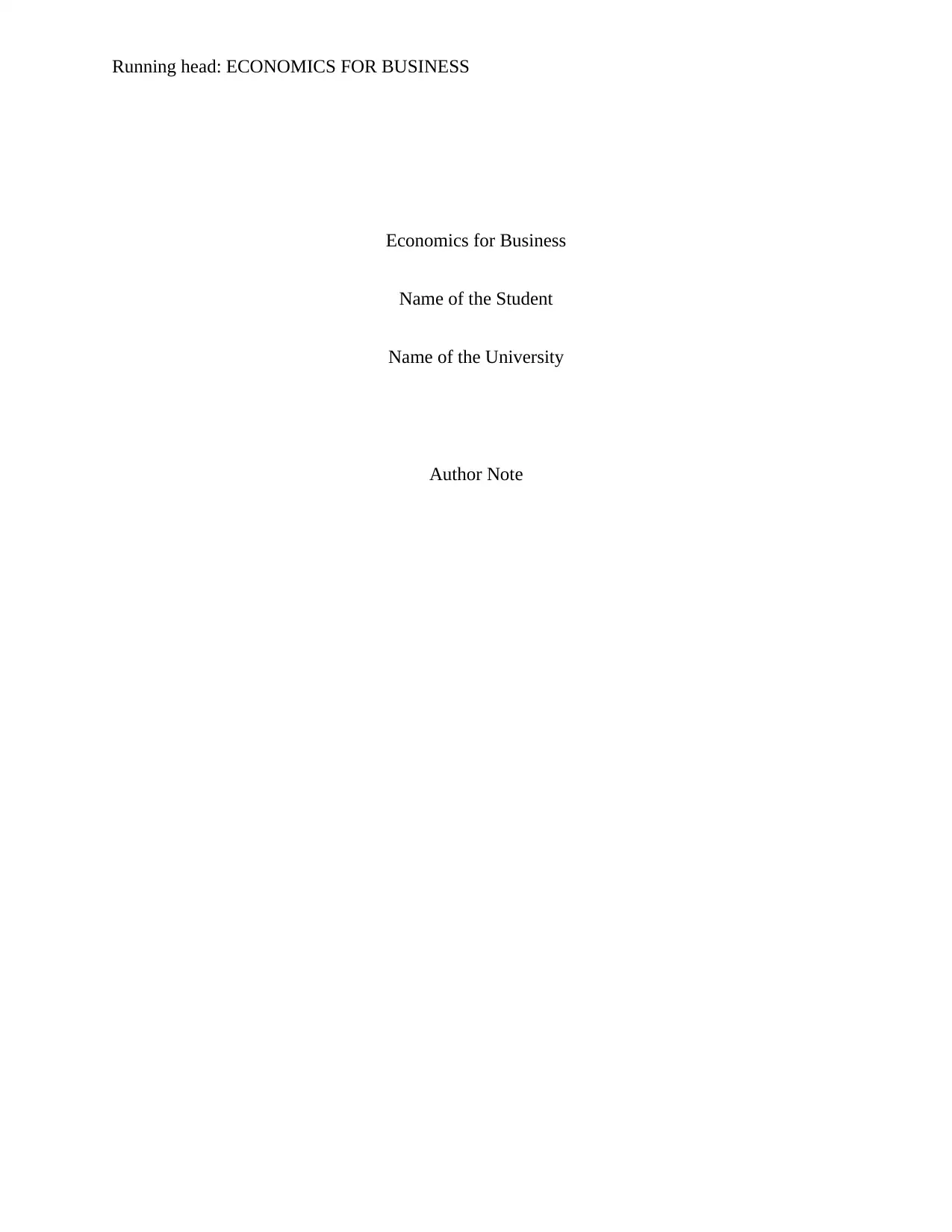
Running head: ECONOMICS FOR BUSINESS
Economics for Business
Name of the Student
Name of the University
Author Note
Economics for Business
Name of the Student
Name of the University
Author Note
Paraphrase This Document
Need a fresh take? Get an instant paraphrase of this document with our AI Paraphraser

1ECONOMICS FOR BUSINESS
Table of Contents
Introduction......................................................................................................................................2
Analysis...........................................................................................................................................2
Stable Equilibrium.......................................................................................................................2
Economic condition of Australia.................................................................................................5
Business Cycle in Australia.........................................................................................................8
Economy of USA.........................................................................................................................9
Economy of China.....................................................................................................................11
Conclusion.....................................................................................................................................14
References......................................................................................................................................15
Table of Contents
Introduction......................................................................................................................................2
Analysis...........................................................................................................................................2
Stable Equilibrium.......................................................................................................................2
Economic condition of Australia.................................................................................................5
Business Cycle in Australia.........................................................................................................8
Economy of USA.........................................................................................................................9
Economy of China.....................................................................................................................11
Conclusion.....................................................................................................................................14
References......................................................................................................................................15
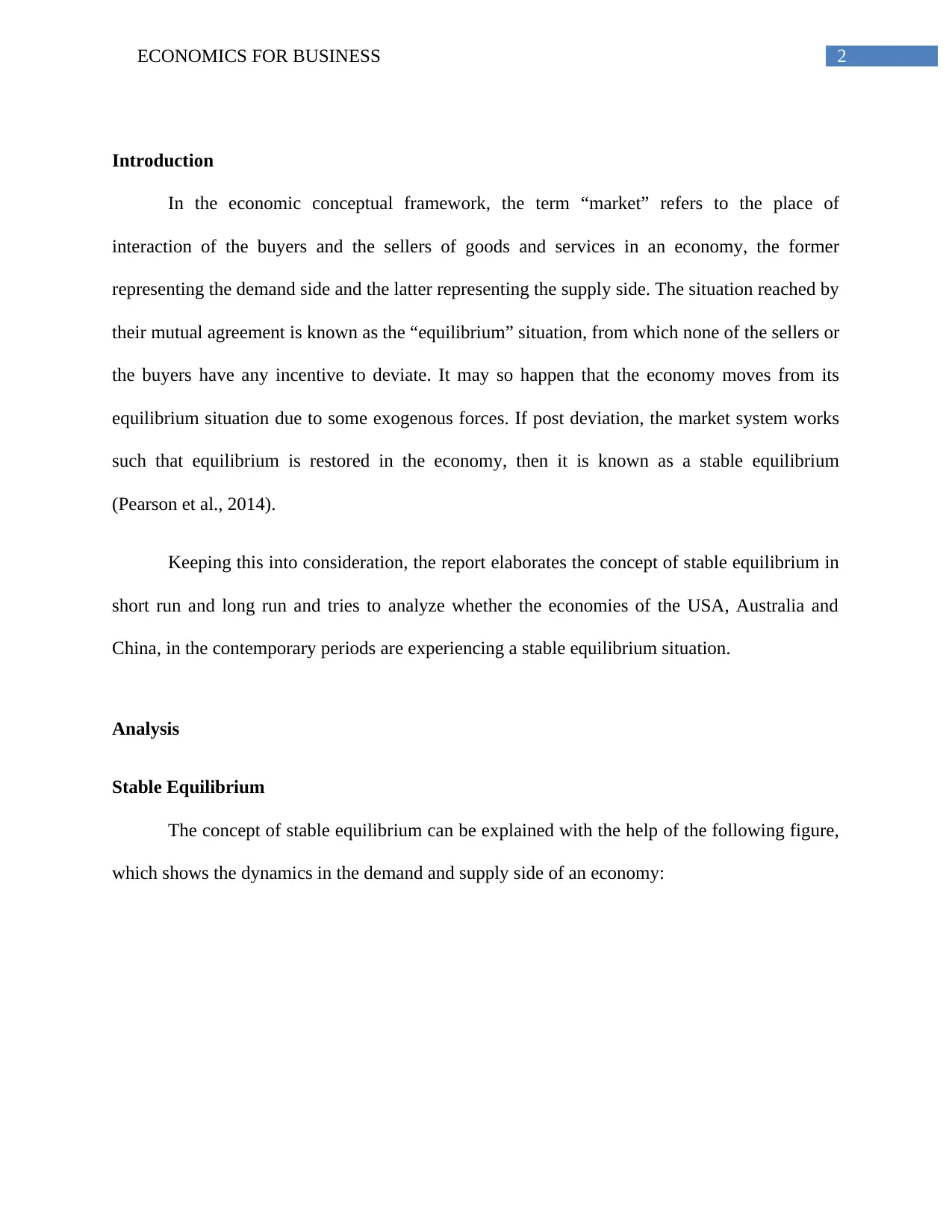
2ECONOMICS FOR BUSINESS
Introduction
In the economic conceptual framework, the term “market” refers to the place of
interaction of the buyers and the sellers of goods and services in an economy, the former
representing the demand side and the latter representing the supply side. The situation reached by
their mutual agreement is known as the “equilibrium” situation, from which none of the sellers or
the buyers have any incentive to deviate. It may so happen that the economy moves from its
equilibrium situation due to some exogenous forces. If post deviation, the market system works
such that equilibrium is restored in the economy, then it is known as a stable equilibrium
(Pearson et al., 2014).
Keeping this into consideration, the report elaborates the concept of stable equilibrium in
short run and long run and tries to analyze whether the economies of the USA, Australia and
China, in the contemporary periods are experiencing a stable equilibrium situation.
Analysis
Stable Equilibrium
The concept of stable equilibrium can be explained with the help of the following figure,
which shows the dynamics in the demand and supply side of an economy:
Introduction
In the economic conceptual framework, the term “market” refers to the place of
interaction of the buyers and the sellers of goods and services in an economy, the former
representing the demand side and the latter representing the supply side. The situation reached by
their mutual agreement is known as the “equilibrium” situation, from which none of the sellers or
the buyers have any incentive to deviate. It may so happen that the economy moves from its
equilibrium situation due to some exogenous forces. If post deviation, the market system works
such that equilibrium is restored in the economy, then it is known as a stable equilibrium
(Pearson et al., 2014).
Keeping this into consideration, the report elaborates the concept of stable equilibrium in
short run and long run and tries to analyze whether the economies of the USA, Australia and
China, in the contemporary periods are experiencing a stable equilibrium situation.
Analysis
Stable Equilibrium
The concept of stable equilibrium can be explained with the help of the following figure,
which shows the dynamics in the demand and supply side of an economy:
You're viewing a preview
Unlock full access by subscribing today!
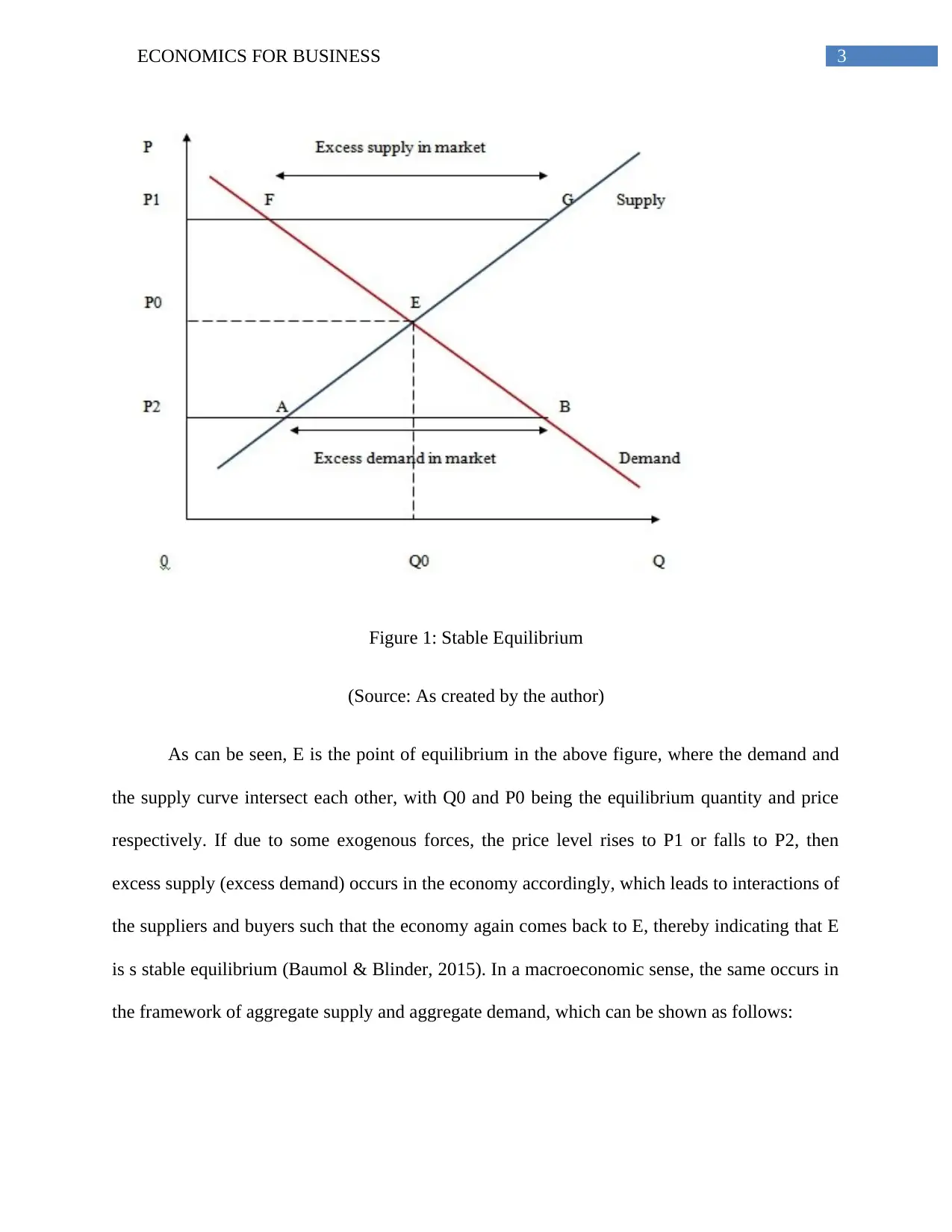
3ECONOMICS FOR BUSINESS
Figure 1: Stable Equilibrium
(Source: As created by the author)
As can be seen, E is the point of equilibrium in the above figure, where the demand and
the supply curve intersect each other, with Q0 and P0 being the equilibrium quantity and price
respectively. If due to some exogenous forces, the price level rises to P1 or falls to P2, then
excess supply (excess demand) occurs in the economy accordingly, which leads to interactions of
the suppliers and buyers such that the economy again comes back to E, thereby indicating that E
is s stable equilibrium (Baumol & Blinder, 2015). In a macroeconomic sense, the same occurs in
the framework of aggregate supply and aggregate demand, which can be shown as follows:
Figure 1: Stable Equilibrium
(Source: As created by the author)
As can be seen, E is the point of equilibrium in the above figure, where the demand and
the supply curve intersect each other, with Q0 and P0 being the equilibrium quantity and price
respectively. If due to some exogenous forces, the price level rises to P1 or falls to P2, then
excess supply (excess demand) occurs in the economy accordingly, which leads to interactions of
the suppliers and buyers such that the economy again comes back to E, thereby indicating that E
is s stable equilibrium (Baumol & Blinder, 2015). In a macroeconomic sense, the same occurs in
the framework of aggregate supply and aggregate demand, which can be shown as follows:
Paraphrase This Document
Need a fresh take? Get an instant paraphrase of this document with our AI Paraphraser
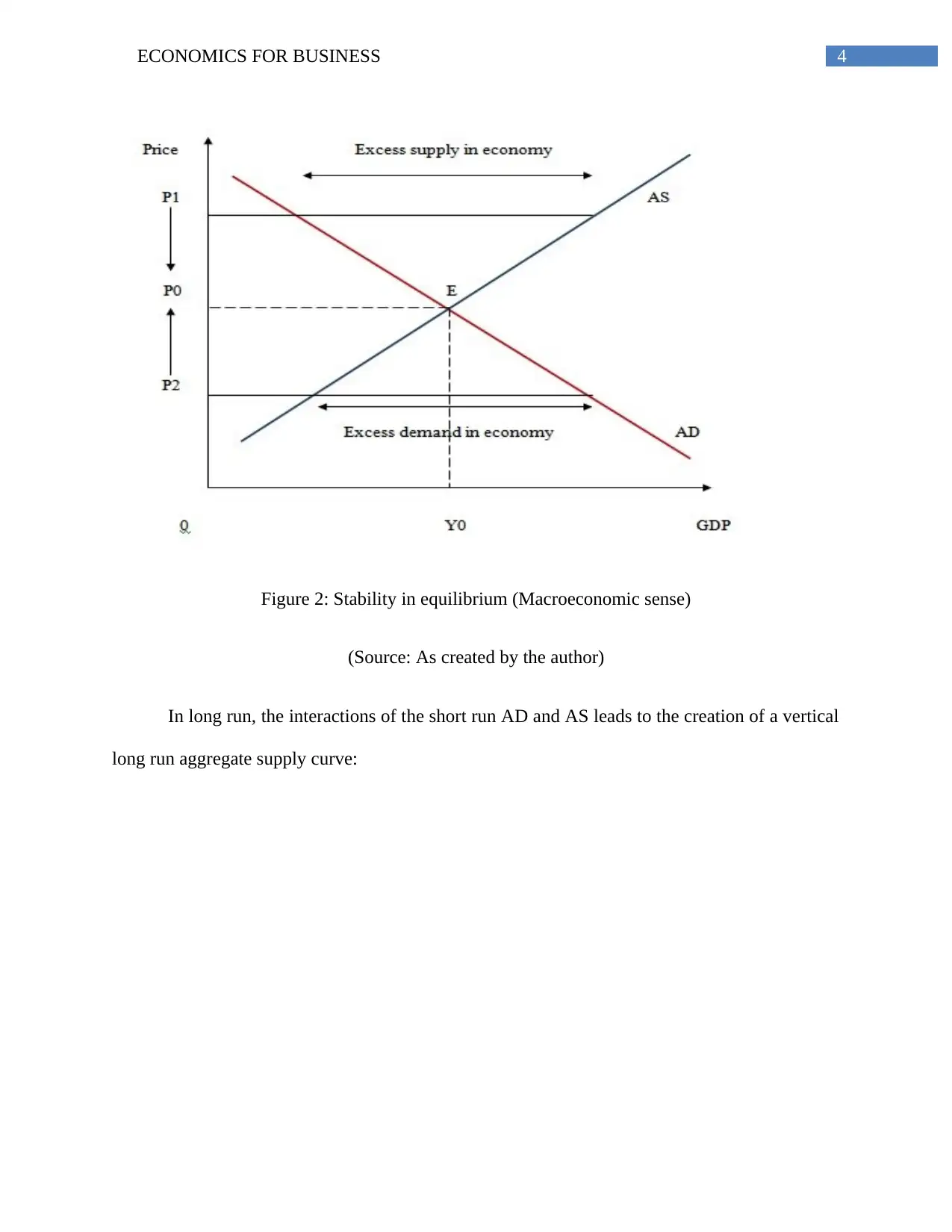
4ECONOMICS FOR BUSINESS
Figure 2: Stability in equilibrium (Macroeconomic sense)
(Source: As created by the author)
In long run, the interactions of the short run AD and AS leads to the creation of a vertical
long run aggregate supply curve:
Figure 2: Stability in equilibrium (Macroeconomic sense)
(Source: As created by the author)
In long run, the interactions of the short run AD and AS leads to the creation of a vertical
long run aggregate supply curve:
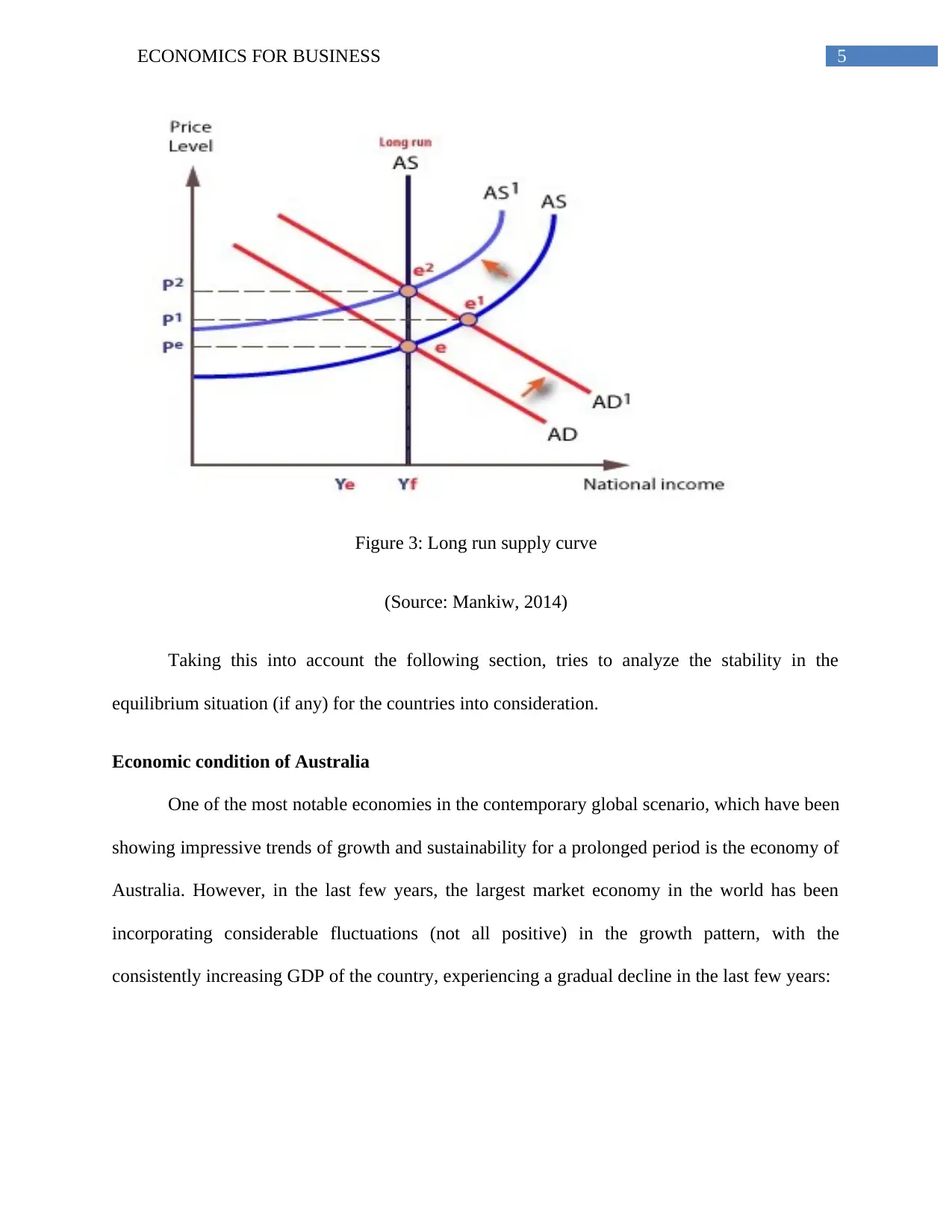
5ECONOMICS FOR BUSINESS
Figure 3: Long run supply curve
(Source: Mankiw, 2014)
Taking this into account the following section, tries to analyze the stability in the
equilibrium situation (if any) for the countries into consideration.
Economic condition of Australia
One of the most notable economies in the contemporary global scenario, which have been
showing impressive trends of growth and sustainability for a prolonged period is the economy of
Australia. However, in the last few years, the largest market economy in the world has been
incorporating considerable fluctuations (not all positive) in the growth pattern, with the
consistently increasing GDP of the country, experiencing a gradual decline in the last few years:
Figure 3: Long run supply curve
(Source: Mankiw, 2014)
Taking this into account the following section, tries to analyze the stability in the
equilibrium situation (if any) for the countries into consideration.
Economic condition of Australia
One of the most notable economies in the contemporary global scenario, which have been
showing impressive trends of growth and sustainability for a prolonged period is the economy of
Australia. However, in the last few years, the largest market economy in the world has been
incorporating considerable fluctuations (not all positive) in the growth pattern, with the
consistently increasing GDP of the country, experiencing a gradual decline in the last few years:
You're viewing a preview
Unlock full access by subscribing today!
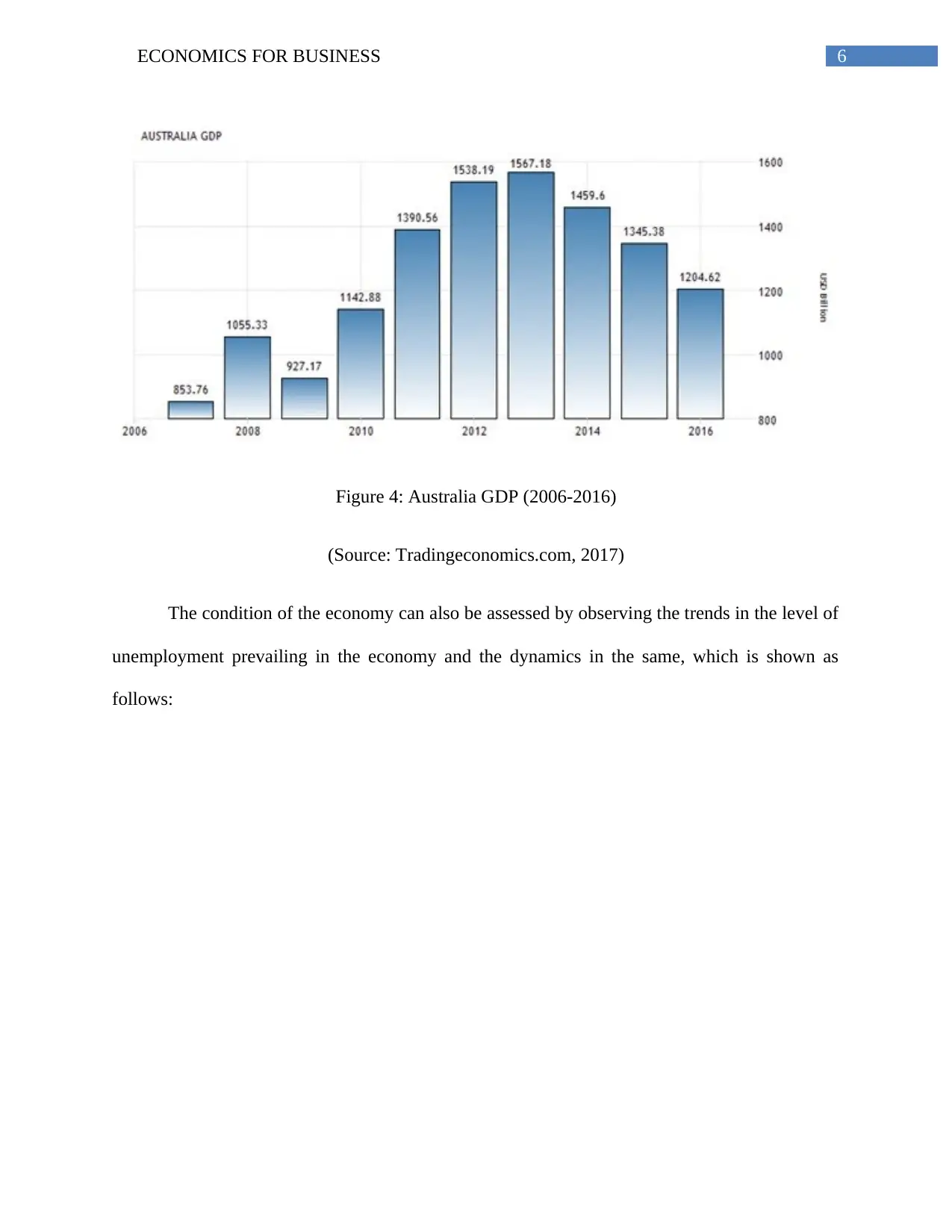
6ECONOMICS FOR BUSINESS
Figure 4: Australia GDP (2006-2016)
(Source: Tradingeconomics.com, 2017)
The condition of the economy can also be assessed by observing the trends in the level of
unemployment prevailing in the economy and the dynamics in the same, which is shown as
follows:
Figure 4: Australia GDP (2006-2016)
(Source: Tradingeconomics.com, 2017)
The condition of the economy can also be assessed by observing the trends in the level of
unemployment prevailing in the economy and the dynamics in the same, which is shown as
follows:
Paraphrase This Document
Need a fresh take? Get an instant paraphrase of this document with our AI Paraphraser
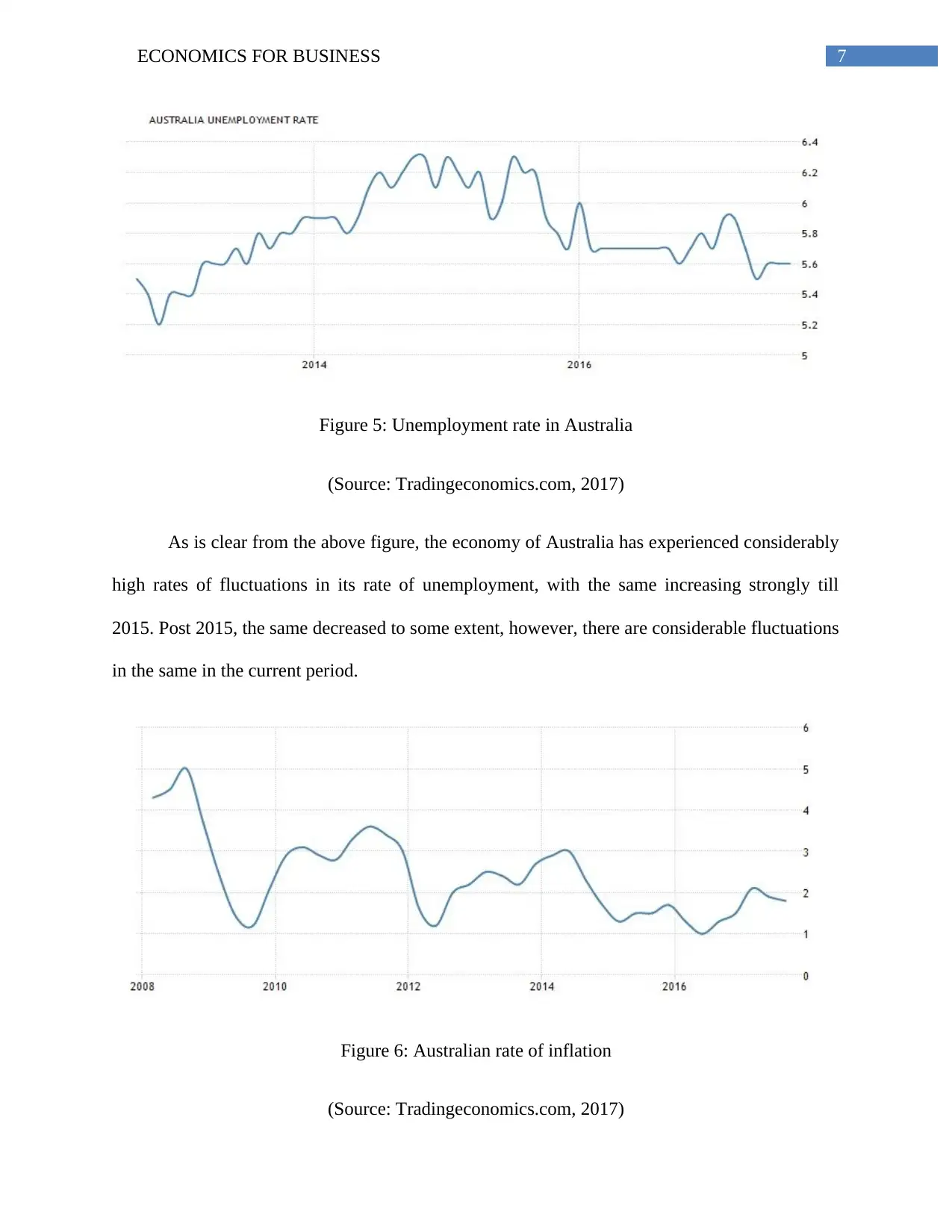
7ECONOMICS FOR BUSINESS
Figure 5: Unemployment rate in Australia
(Source: Tradingeconomics.com, 2017)
As is clear from the above figure, the economy of Australia has experienced considerably
high rates of fluctuations in its rate of unemployment, with the same increasing strongly till
2015. Post 2015, the same decreased to some extent, however, there are considerable fluctuations
in the same in the current period.
Figure 6: Australian rate of inflation
(Source: Tradingeconomics.com, 2017)
Figure 5: Unemployment rate in Australia
(Source: Tradingeconomics.com, 2017)
As is clear from the above figure, the economy of Australia has experienced considerably
high rates of fluctuations in its rate of unemployment, with the same increasing strongly till
2015. Post 2015, the same decreased to some extent, however, there are considerable fluctuations
in the same in the current period.
Figure 6: Australian rate of inflation
(Source: Tradingeconomics.com, 2017)
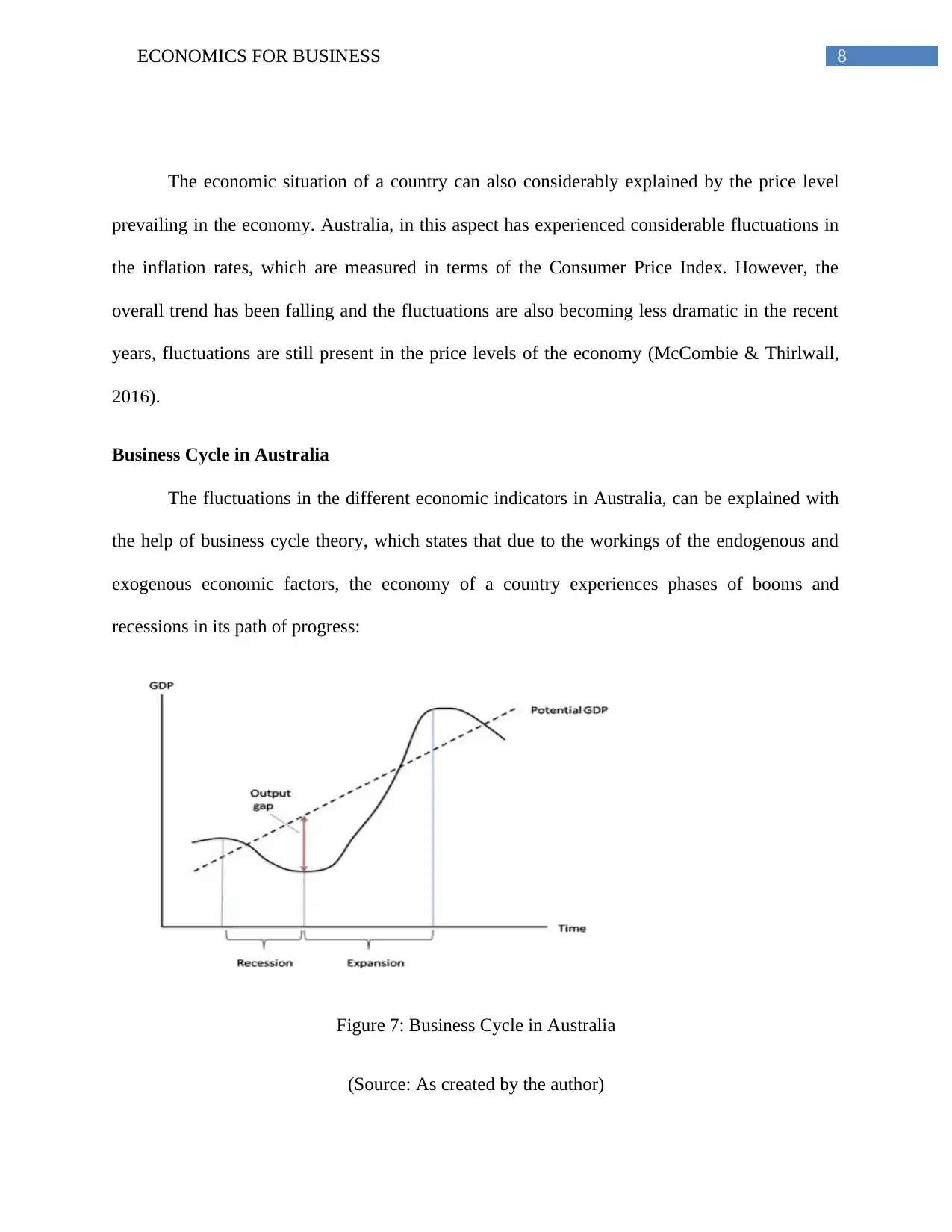
8ECONOMICS FOR BUSINESS
The economic situation of a country can also considerably explained by the price level
prevailing in the economy. Australia, in this aspect has experienced considerable fluctuations in
the inflation rates, which are measured in terms of the Consumer Price Index. However, the
overall trend has been falling and the fluctuations are also becoming less dramatic in the recent
years, fluctuations are still present in the price levels of the economy (McCombie & Thirlwall,
2016).
Business Cycle in Australia
The fluctuations in the different economic indicators in Australia, can be explained with
the help of business cycle theory, which states that due to the workings of the endogenous and
exogenous economic factors, the economy of a country experiences phases of booms and
recessions in its path of progress:
Figure 7: Business Cycle in Australia
(Source: As created by the author)
The economic situation of a country can also considerably explained by the price level
prevailing in the economy. Australia, in this aspect has experienced considerable fluctuations in
the inflation rates, which are measured in terms of the Consumer Price Index. However, the
overall trend has been falling and the fluctuations are also becoming less dramatic in the recent
years, fluctuations are still present in the price levels of the economy (McCombie & Thirlwall,
2016).
Business Cycle in Australia
The fluctuations in the different economic indicators in Australia, can be explained with
the help of business cycle theory, which states that due to the workings of the endogenous and
exogenous economic factors, the economy of a country experiences phases of booms and
recessions in its path of progress:
Figure 7: Business Cycle in Australia
(Source: As created by the author)
You're viewing a preview
Unlock full access by subscribing today!
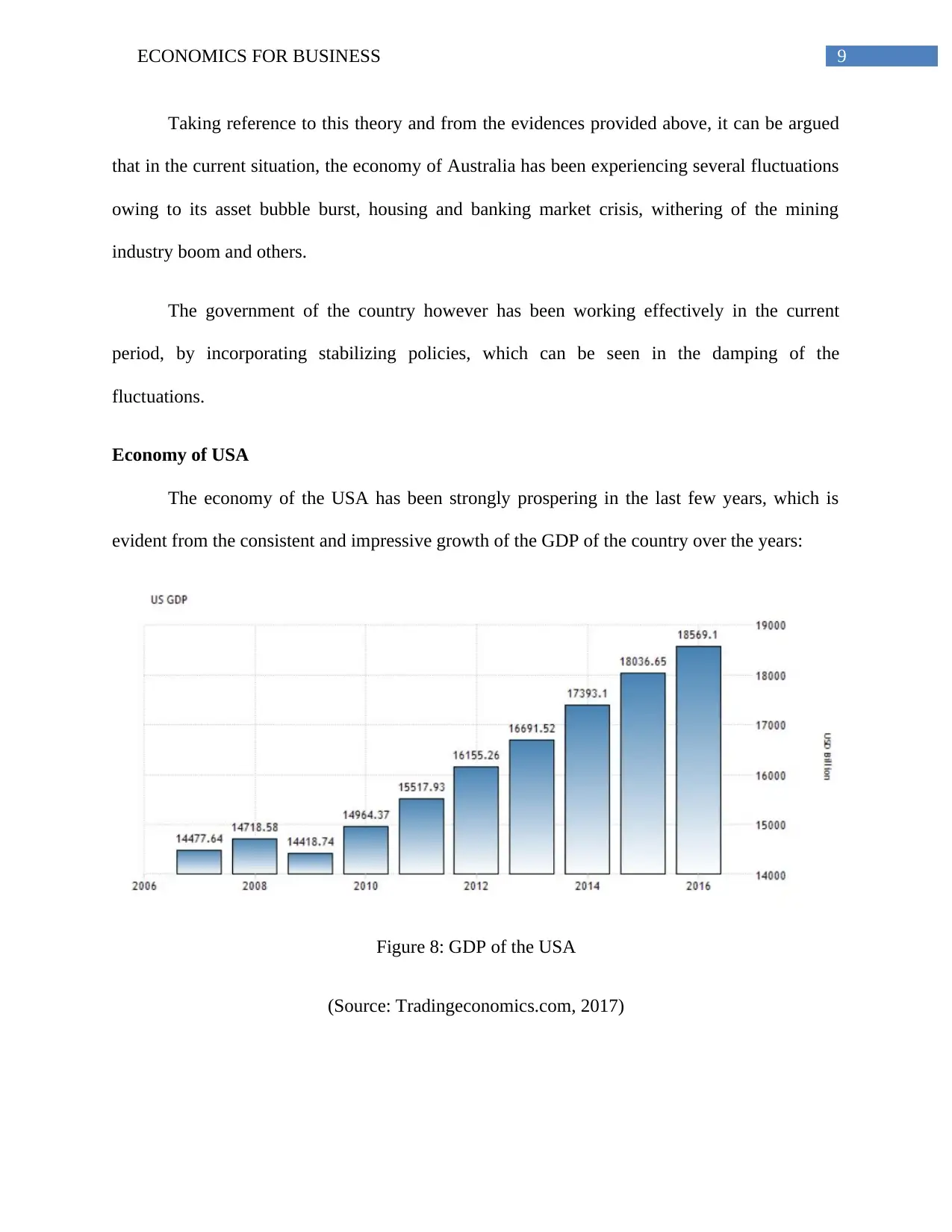
9ECONOMICS FOR BUSINESS
Taking reference to this theory and from the evidences provided above, it can be argued
that in the current situation, the economy of Australia has been experiencing several fluctuations
owing to its asset bubble burst, housing and banking market crisis, withering of the mining
industry boom and others.
The government of the country however has been working effectively in the current
period, by incorporating stabilizing policies, which can be seen in the damping of the
fluctuations.
Economy of USA
The economy of the USA has been strongly prospering in the last few years, which is
evident from the consistent and impressive growth of the GDP of the country over the years:
Figure 8: GDP of the USA
(Source: Tradingeconomics.com, 2017)
Taking reference to this theory and from the evidences provided above, it can be argued
that in the current situation, the economy of Australia has been experiencing several fluctuations
owing to its asset bubble burst, housing and banking market crisis, withering of the mining
industry boom and others.
The government of the country however has been working effectively in the current
period, by incorporating stabilizing policies, which can be seen in the damping of the
fluctuations.
Economy of USA
The economy of the USA has been strongly prospering in the last few years, which is
evident from the consistent and impressive growth of the GDP of the country over the years:
Figure 8: GDP of the USA
(Source: Tradingeconomics.com, 2017)
Paraphrase This Document
Need a fresh take? Get an instant paraphrase of this document with our AI Paraphraser
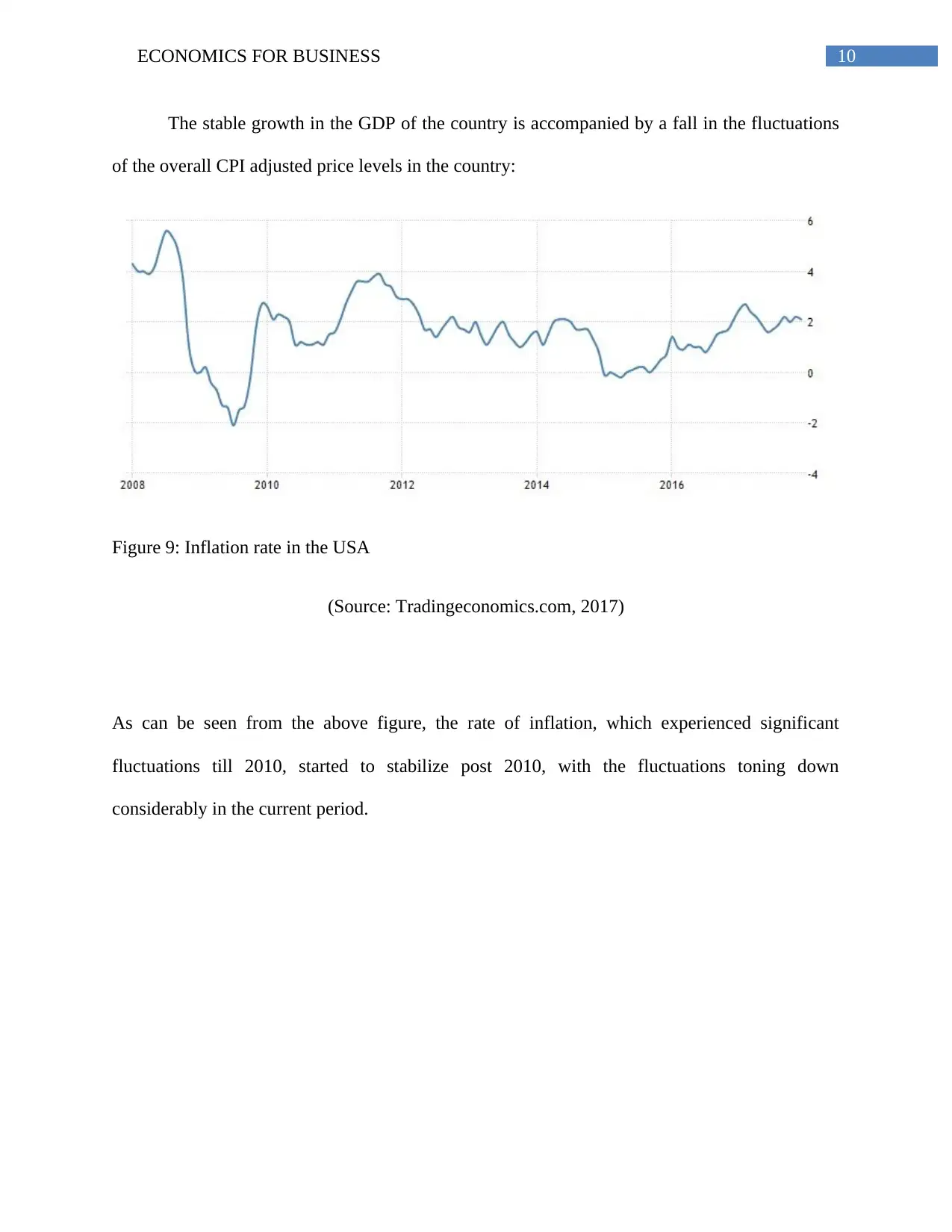
10ECONOMICS FOR BUSINESS
The stable growth in the GDP of the country is accompanied by a fall in the fluctuations
of the overall CPI adjusted price levels in the country:
Figure 9: Inflation rate in the USA
(Source: Tradingeconomics.com, 2017)
As can be seen from the above figure, the rate of inflation, which experienced significant
fluctuations till 2010, started to stabilize post 2010, with the fluctuations toning down
considerably in the current period.
The stable growth in the GDP of the country is accompanied by a fall in the fluctuations
of the overall CPI adjusted price levels in the country:
Figure 9: Inflation rate in the USA
(Source: Tradingeconomics.com, 2017)
As can be seen from the above figure, the rate of inflation, which experienced significant
fluctuations till 2010, started to stabilize post 2010, with the fluctuations toning down
considerably in the current period.

11ECONOMICS FOR BUSINESS
Figure 10: Unemployment Rate in the USA (2014-2017)
(Source: Tradingeconomics.com, 2017)
The rate of unemployment in the country has been consistently decreasing consistently
over the last few years and the fluctuations have also damped considerably during this time.
Together, these economic trends indicate that the USA has been reaching towards the
situation of a stable equilibrium in the contemporary period (Schneider, 2013).
Economy of China
One of the primary global economies, which have been growing at an outstandingly
impressive rate and has surpassed the developed economies in terms of economic growth, is the
economy China. The country is the second largest in the international scenario in terms of GDP
growth which can be seen from the following figure:
Figure 10: Unemployment Rate in the USA (2014-2017)
(Source: Tradingeconomics.com, 2017)
The rate of unemployment in the country has been consistently decreasing consistently
over the last few years and the fluctuations have also damped considerably during this time.
Together, these economic trends indicate that the USA has been reaching towards the
situation of a stable equilibrium in the contemporary period (Schneider, 2013).
Economy of China
One of the primary global economies, which have been growing at an outstandingly
impressive rate and has surpassed the developed economies in terms of economic growth, is the
economy China. The country is the second largest in the international scenario in terms of GDP
growth which can be seen from the following figure:
You're viewing a preview
Unlock full access by subscribing today!
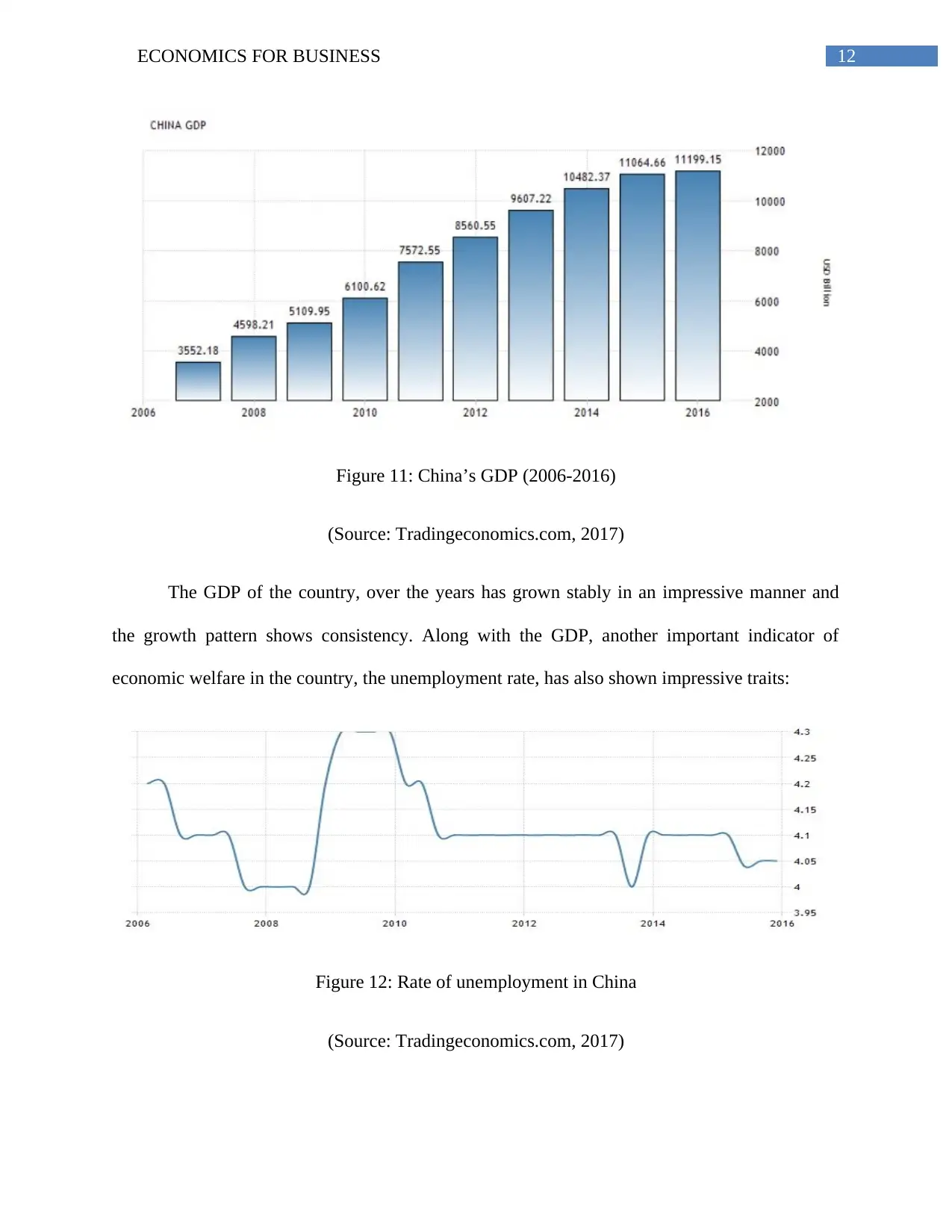
12ECONOMICS FOR BUSINESS
Figure 11: China’s GDP (2006-2016)
(Source: Tradingeconomics.com, 2017)
The GDP of the country, over the years has grown stably in an impressive manner and
the growth pattern shows consistency. Along with the GDP, another important indicator of
economic welfare in the country, the unemployment rate, has also shown impressive traits:
Figure 12: Rate of unemployment in China
(Source: Tradingeconomics.com, 2017)
Figure 11: China’s GDP (2006-2016)
(Source: Tradingeconomics.com, 2017)
The GDP of the country, over the years has grown stably in an impressive manner and
the growth pattern shows consistency. Along with the GDP, another important indicator of
economic welfare in the country, the unemployment rate, has also shown impressive traits:
Figure 12: Rate of unemployment in China
(Source: Tradingeconomics.com, 2017)
Paraphrase This Document
Need a fresh take? Get an instant paraphrase of this document with our AI Paraphraser
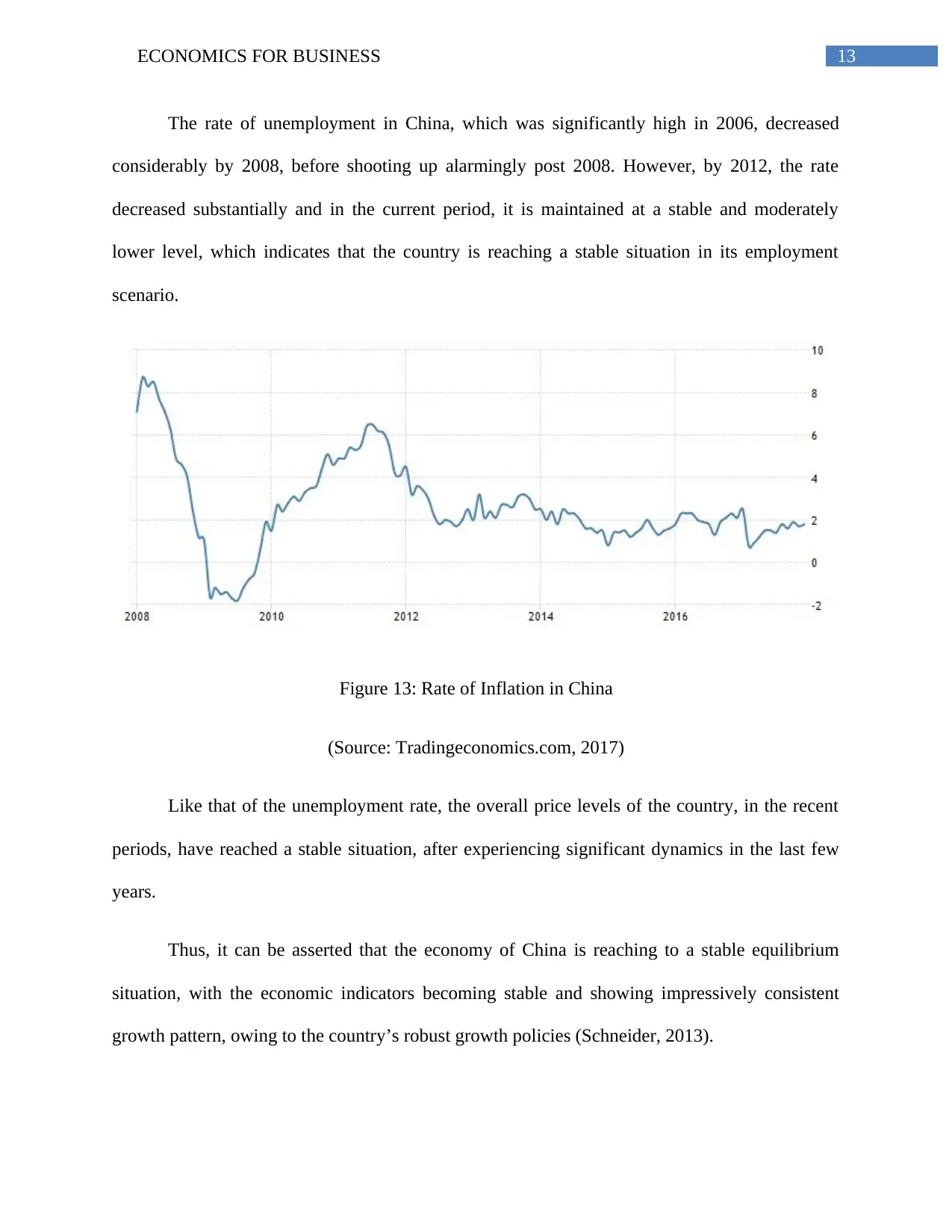
13ECONOMICS FOR BUSINESS
The rate of unemployment in China, which was significantly high in 2006, decreased
considerably by 2008, before shooting up alarmingly post 2008. However, by 2012, the rate
decreased substantially and in the current period, it is maintained at a stable and moderately
lower level, which indicates that the country is reaching a stable situation in its employment
scenario.
Figure 13: Rate of Inflation in China
(Source: Tradingeconomics.com, 2017)
Like that of the unemployment rate, the overall price levels of the country, in the recent
periods, have reached a stable situation, after experiencing significant dynamics in the last few
years.
Thus, it can be asserted that the economy of China is reaching to a stable equilibrium
situation, with the economic indicators becoming stable and showing impressively consistent
growth pattern, owing to the country’s robust growth policies (Schneider, 2013).
The rate of unemployment in China, which was significantly high in 2006, decreased
considerably by 2008, before shooting up alarmingly post 2008. However, by 2012, the rate
decreased substantially and in the current period, it is maintained at a stable and moderately
lower level, which indicates that the country is reaching a stable situation in its employment
scenario.
Figure 13: Rate of Inflation in China
(Source: Tradingeconomics.com, 2017)
Like that of the unemployment rate, the overall price levels of the country, in the recent
periods, have reached a stable situation, after experiencing significant dynamics in the last few
years.
Thus, it can be asserted that the economy of China is reaching to a stable equilibrium
situation, with the economic indicators becoming stable and showing impressively consistent
growth pattern, owing to the country’s robust growth policies (Schneider, 2013).
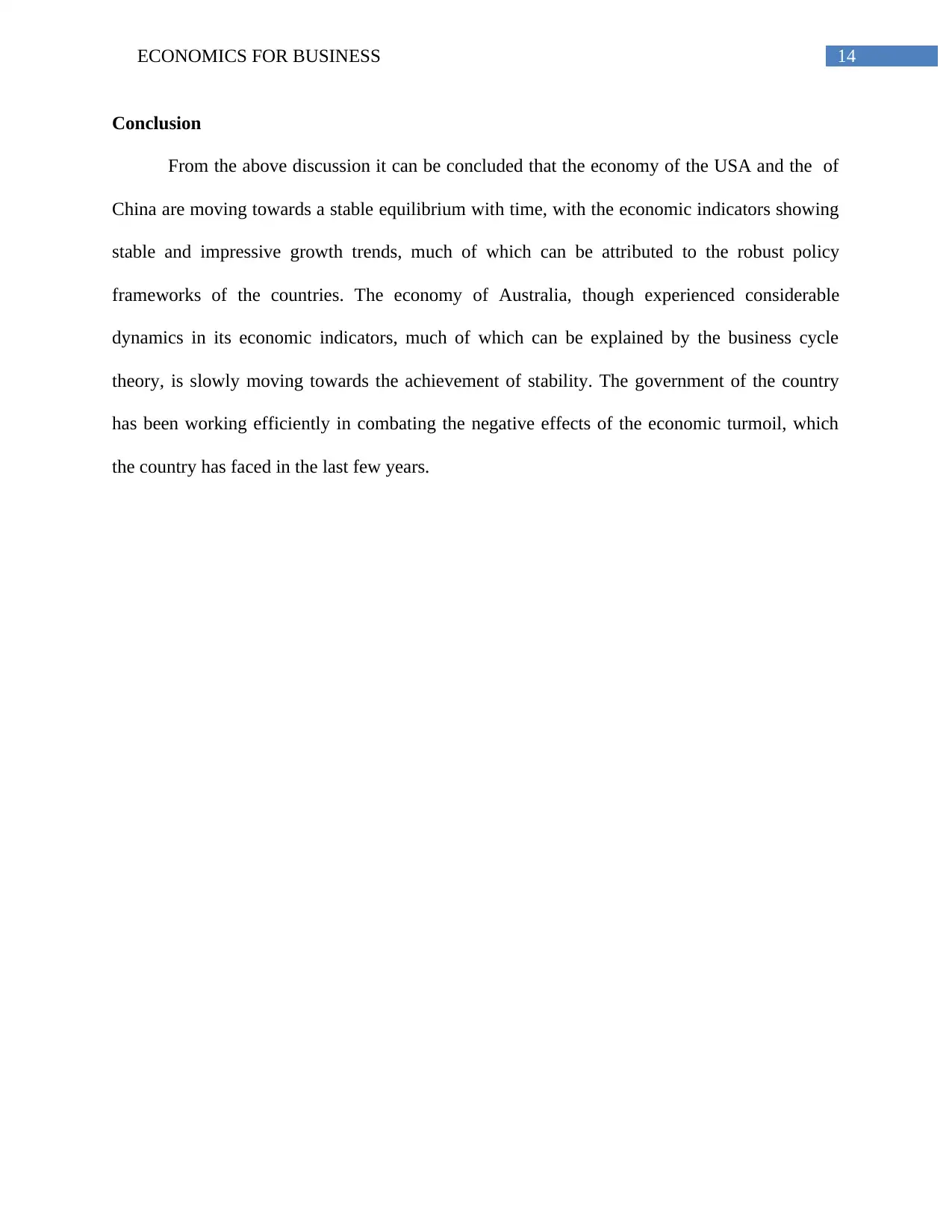
14ECONOMICS FOR BUSINESS
Conclusion
From the above discussion it can be concluded that the economy of the USA and the of
China are moving towards a stable equilibrium with time, with the economic indicators showing
stable and impressive growth trends, much of which can be attributed to the robust policy
frameworks of the countries. The economy of Australia, though experienced considerable
dynamics in its economic indicators, much of which can be explained by the business cycle
theory, is slowly moving towards the achievement of stability. The government of the country
has been working efficiently in combating the negative effects of the economic turmoil, which
the country has faced in the last few years.
Conclusion
From the above discussion it can be concluded that the economy of the USA and the of
China are moving towards a stable equilibrium with time, with the economic indicators showing
stable and impressive growth trends, much of which can be attributed to the robust policy
frameworks of the countries. The economy of Australia, though experienced considerable
dynamics in its economic indicators, much of which can be explained by the business cycle
theory, is slowly moving towards the achievement of stability. The government of the country
has been working efficiently in combating the negative effects of the economic turmoil, which
the country has faced in the last few years.
You're viewing a preview
Unlock full access by subscribing today!
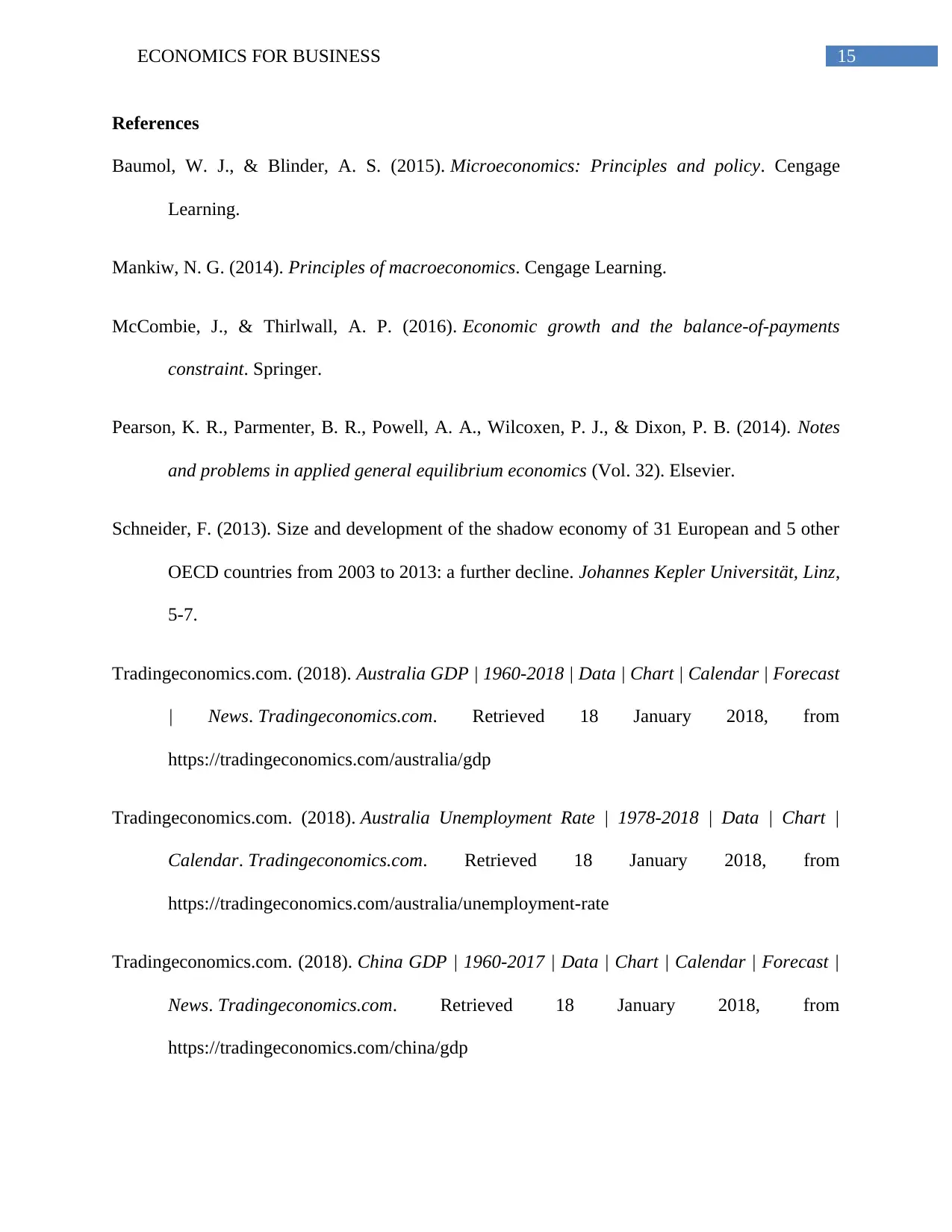
15ECONOMICS FOR BUSINESS
References
Baumol, W. J., & Blinder, A. S. (2015). Microeconomics: Principles and policy. Cengage
Learning.
Mankiw, N. G. (2014). Principles of macroeconomics. Cengage Learning.
McCombie, J., & Thirlwall, A. P. (2016). Economic growth and the balance-of-payments
constraint. Springer.
Pearson, K. R., Parmenter, B. R., Powell, A. A., Wilcoxen, P. J., & Dixon, P. B. (2014). Notes
and problems in applied general equilibrium economics (Vol. 32). Elsevier.
Schneider, F. (2013). Size and development of the shadow economy of 31 European and 5 other
OECD countries from 2003 to 2013: a further decline. Johannes Kepler Universität, Linz,
5-7.
Tradingeconomics.com. (2018). Australia GDP | 1960-2018 | Data | Chart | Calendar | Forecast
| News. Tradingeconomics.com. Retrieved 18 January 2018, from
https://tradingeconomics.com/australia/gdp
Tradingeconomics.com. (2018). Australia Unemployment Rate | 1978-2018 | Data | Chart |
Calendar. Tradingeconomics.com. Retrieved 18 January 2018, from
https://tradingeconomics.com/australia/unemployment-rate
Tradingeconomics.com. (2018). China GDP | 1960-2017 | Data | Chart | Calendar | Forecast |
News. Tradingeconomics.com. Retrieved 18 January 2018, from
https://tradingeconomics.com/china/gdp
References
Baumol, W. J., & Blinder, A. S. (2015). Microeconomics: Principles and policy. Cengage
Learning.
Mankiw, N. G. (2014). Principles of macroeconomics. Cengage Learning.
McCombie, J., & Thirlwall, A. P. (2016). Economic growth and the balance-of-payments
constraint. Springer.
Pearson, K. R., Parmenter, B. R., Powell, A. A., Wilcoxen, P. J., & Dixon, P. B. (2014). Notes
and problems in applied general equilibrium economics (Vol. 32). Elsevier.
Schneider, F. (2013). Size and development of the shadow economy of 31 European and 5 other
OECD countries from 2003 to 2013: a further decline. Johannes Kepler Universität, Linz,
5-7.
Tradingeconomics.com. (2018). Australia GDP | 1960-2018 | Data | Chart | Calendar | Forecast
| News. Tradingeconomics.com. Retrieved 18 January 2018, from
https://tradingeconomics.com/australia/gdp
Tradingeconomics.com. (2018). Australia Unemployment Rate | 1978-2018 | Data | Chart |
Calendar. Tradingeconomics.com. Retrieved 18 January 2018, from
https://tradingeconomics.com/australia/unemployment-rate
Tradingeconomics.com. (2018). China GDP | 1960-2017 | Data | Chart | Calendar | Forecast |
News. Tradingeconomics.com. Retrieved 18 January 2018, from
https://tradingeconomics.com/china/gdp
Paraphrase This Document
Need a fresh take? Get an instant paraphrase of this document with our AI Paraphraser
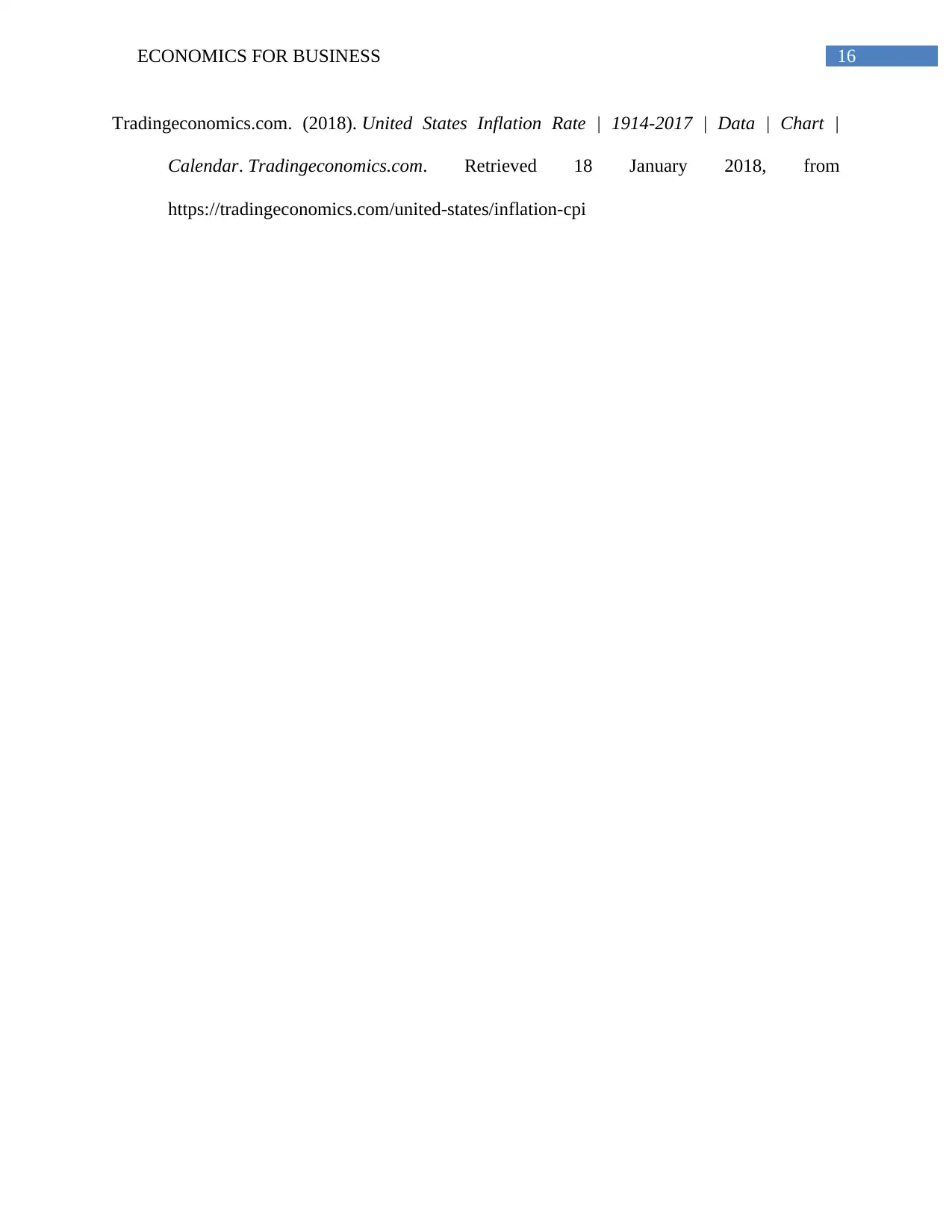
16ECONOMICS FOR BUSINESS
Tradingeconomics.com. (2018). United States Inflation Rate | 1914-2017 | Data | Chart |
Calendar. Tradingeconomics.com. Retrieved 18 January 2018, from
https://tradingeconomics.com/united-states/inflation-cpi
Tradingeconomics.com. (2018). United States Inflation Rate | 1914-2017 | Data | Chart |
Calendar. Tradingeconomics.com. Retrieved 18 January 2018, from
https://tradingeconomics.com/united-states/inflation-cpi
1 out of 17
Related Documents
Your All-in-One AI-Powered Toolkit for Academic Success.
+13062052269
info@desklib.com
Available 24*7 on WhatsApp / Email
![[object Object]](/_next/static/media/star-bottom.7253800d.svg)
Unlock your academic potential
© 2024 | Zucol Services PVT LTD | All rights reserved.





